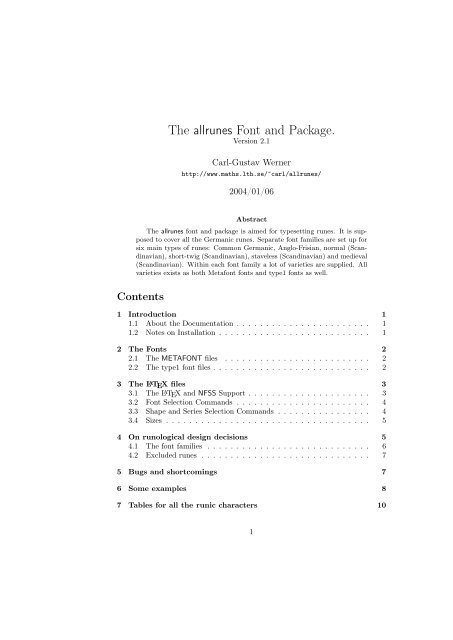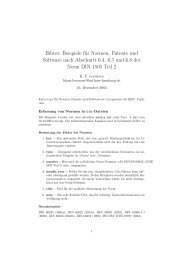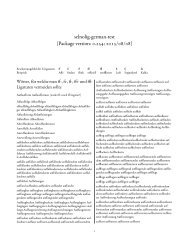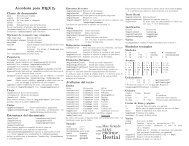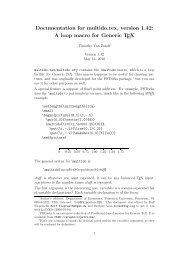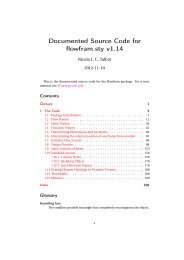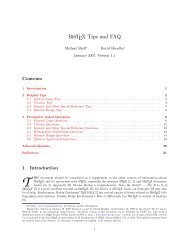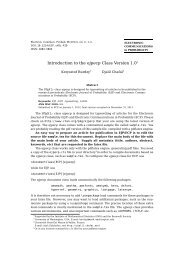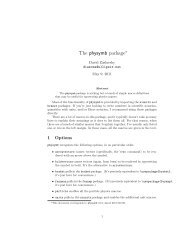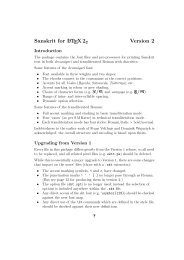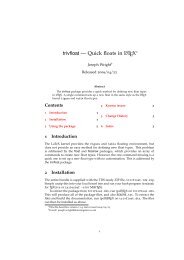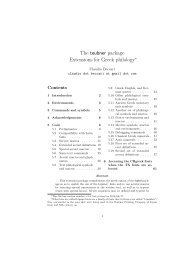The allrunes Font and Package. - CTAN
The allrunes Font and Package. - CTAN
The allrunes Font and Package. - CTAN
Create successful ePaper yourself
Turn your PDF publications into a flip-book with our unique Google optimized e-Paper software.
<strong>The</strong> <strong>allrunes</strong> <strong>Font</strong> <strong>and</strong> <strong>Package</strong>.<br />
Version 2.1<br />
Carl-Gustav Werner<br />
http://www.maths.lth.se/˜carl/<strong>allrunes</strong>/<br />
2004/01/06<br />
Abstract<br />
<strong>The</strong> <strong>allrunes</strong> font <strong>and</strong> package is aimed for typesetting runes. It is supposed<br />
to cover all the Germanic runes. Separate font families are set up for<br />
six main types of runes: Common Germanic, Anglo-Frisian, normal (Sc<strong>and</strong>inavian),<br />
short-twig (Sc<strong>and</strong>inavian), staveless (Sc<strong>and</strong>inavian) <strong>and</strong> medieval<br />
(Sc<strong>and</strong>inavian). Within each font family a lot of varieties are supplied. All<br />
varieties exists as both Metafont fonts <strong>and</strong> type1 fonts as well.<br />
Contents<br />
1 Introduction 1<br />
1.1 About the Documentation . . . . . . . . . . . . . . . . . . . . . . . 1<br />
1.2 Notes on Installation . . . . . . . . . . . . . . . . . . . . . . . . . . 1<br />
2 <strong>The</strong> <strong>Font</strong>s 2<br />
2.1 <strong>The</strong> METAFONT files . . . . . . . . . . . . . . . . . . . . . . . . . 2<br />
2.2 <strong>The</strong> type1 font files . . . . . . . . . . . . . . . . . . . . . . . . . . . 2<br />
3 <strong>The</strong> L ATEX files 3<br />
3.1 <strong>The</strong> L ATEX <strong>and</strong> NFSS Support . . . . . . . . . . . . . . . . . . . . . 3<br />
3.2 <strong>Font</strong> Selection Comm<strong>and</strong>s . . . . . . . . . . . . . . . . . . . . . . . 4<br />
3.3 Shape <strong>and</strong> Series Selection Comm<strong>and</strong>s . . . . . . . . . . . . . . . . 4<br />
3.4 Sizes . . . . . . . . . . . . . . . . . . . . . . . . . . . . . . . . . . . 5<br />
4 On runological design decisions 5<br />
4.1 <strong>The</strong> font families . . . . . . . . . . . . . . . . . . . . . . . . . . . . 6<br />
4.2 Excluded runes . . . . . . . . . . . . . . . . . . . . . . . . . . . . . 7<br />
5 Bugs <strong>and</strong> shortcomings 7<br />
6 Some examples 8<br />
7 Tables for all the runic characters 10<br />
1
1 Introduction<br />
This package contains the METAFONT source <strong>and</strong> driver files for the <strong>allrunes</strong> font<br />
families, type1 files for the main varieties, plus a L ATEX package to utilize those<br />
fonts, along with a number of font definition files, as required by the New <strong>Font</strong><br />
Selection Scheme (NFSS).<br />
1.1 About the Documentation<br />
<strong>The</strong> full documentation of this font <strong>and</strong> package is rather large, something like<br />
187 pages actually. Most of it is the METAFONT programs for the characters<br />
for the fonts; to make them visible, just remove the \OnlyDescription from the<br />
preamble of <strong>allrunes</strong>.dtx.<br />
1.2 Notes on Installation<br />
<strong>The</strong> information in this documentation can be usefull if you intend to install<br />
the <strong>allrunes</strong> font <strong>and</strong> package, <strong>and</strong> it is intended be sufficient. However, in some<br />
TeX-implementations (like MiKTeX) the <strong>allrunes</strong> font <strong>and</strong> package is part of the<br />
distribution; in such cases it is easier to use that.<br />
2 <strong>The</strong> <strong>Font</strong>s<br />
Both METAFONT source files <strong>and</strong> type1 font files are supplied. It is recommended<br />
to install either just the METAFONT files, or both of them.<br />
2.1 <strong>The</strong> METAFONT files<br />
Base File <strong>and</strong> Source Files <strong>The</strong> names of the base file <strong>and</strong> the files containing<br />
the code for the characters of the <strong>allrunes</strong> font all starts with the letters fru. <strong>The</strong><br />
next five possible letters reflects what kind of code is contained within the file,<br />
e.g., the base file ends in base, the file containing the code for the word separators<br />
end in sep, <strong>and</strong> so forth.<br />
<strong>Font</strong> Driver Files <strong>The</strong> font driver filenames has been chosen to conform to the<br />
fontname scheme, as far as possible.<br />
<strong>The</strong> filename all contain the three characters fru, where, according to the the<br />
fontname scheme, f st<strong>and</strong>s for public <strong>and</strong> ru for runic.<br />
Next comes one of the following letters: c (Common Germanic), a (Anglo-<br />
Frisian), n (Normal), t (Short-twig), l (Staveless) or m (Medieval) which represents<br />
which of the six rune font families it is.<br />
<strong>The</strong>n comes another letter, which is one of: l (Light face, without lines), m<br />
(Medium, without lines), b (Bold face, without lines), k (Light face, with lines), n<br />
(Medium, with lines) or c (Bold face, with lines), which represents the series, <strong>and</strong><br />
with/without alignment lines.<br />
2
<strong>and</strong> finally comes one of following: s (Straight twigs, top twig not lowered), n<br />
(Curved twigs, top twig not lowered), r (Rounded twigs, top twig not lowered), t<br />
(Straight twigs, top twig lowered), m (Curved twigs, top twig lowered) or q (Rounded<br />
twigs, top twig lowered), which represents two kinds of shape — the curvature of<br />
the twigs, <strong>and</strong> the position of the top twig.<br />
<strong>The</strong> most reasonable place for the fru*.mf files provided with this package is<br />
in a directory named<br />
〈mf–source–base–dir〉/public/<strong>allrunes</strong>/.<br />
This way of naming the font driver files will, if kpathsea is in use, put the fru*.pk<br />
files in<br />
〈pk–base–dir〉/public/<strong>allrunes</strong>/<br />
<strong>and</strong> the fru*.tfm files in<br />
〈tfm–base–dir〉/public/<strong>allrunes</strong>/.<br />
2.2 <strong>The</strong> type1 font files<br />
<strong>The</strong> names of the type1 font files (the fru*.pfb files) are identical to the corresponding<br />
fru*.mf files, with just the suffix exchanged.<br />
<strong>The</strong> most reasonable place for the fru*.pfb files provided with this package<br />
is in a directory named<br />
〈type1–base–dir〉/public/<strong>allrunes</strong>/.<br />
<strong>The</strong> type1 font files are generated from the METAFONT font files with the<br />
program mftrace [Nienhuys 2003].<br />
<strong>The</strong> map file To be able to use the type1 fonts, programs like dvips <strong>and</strong> pdflatex<br />
needs information about which *.pfb file a certain fontname corresponds to. This<br />
information is normally stored in a file 〈dvips-base-dir〉/config/psfonts.map, but<br />
additional information may reside in other *.map files. In the <strong>allrunes</strong> bundle, a<br />
such file called <strong>allrunes</strong>.map is supplied. <strong>The</strong>re are several reasonable places for<br />
it, but 〈dvips-base-dir〉/<strong>allrunes</strong> would be fine.<br />
In recent versions of (at least) the MiKTeX- <strong>and</strong> teTeX-implementations, the<br />
h<strong>and</strong>ling of *.map files is rather simple. Look in the directory 〈tex-base-dir〉/web2c/.<br />
If there is a file called updmap.cfg, open it for editing <strong>and</strong> add a line:<br />
MixedMap <strong>allrunes</strong>.map<br />
(if you have both the METAFONT files <strong>and</strong> the type1 files installed), or<br />
Map <strong>allrunes</strong>.map<br />
(if you only have the type1 files installed) in some suitable place. <strong>The</strong>n update<br />
the other *.map files by running the comm<strong>and</strong>:<br />
initexmf -v –mkmap<br />
if you are using MiKTeX. If you are using teTeX, use the comm<strong>and</strong>:<br />
updmap<br />
Older versions requires more work: edit the file 〈dvips-base-dir〉/config/config.ps,<br />
in which a line:<br />
p +<strong>allrunes</strong>.map<br />
should be inserted somewhere after the line:<br />
3
p psfonts.map<br />
In a similar way, to make pdflatex find the <strong>allrunes</strong>.map, insert a line:<br />
map +<strong>allrunes</strong>.map<br />
somewhere after the line:<br />
map psfonts.map.<br />
in the file 〈pdftex-base-dir〉/config/pdftex.cfg.<br />
3 <strong>The</strong> L ATEX files<br />
To follow the scheme of the METAFONT files, it would be appropriate to place all<br />
L ATEX files, namely the ar?.fd <strong>and</strong> the <strong>allrunes</strong>.sty files, in<br />
〈tex-base-dir〉/tex/latex/<strong>allrunes</strong>/.<br />
3.1 <strong>The</strong> L ATEX <strong>and</strong> NFSS Support<br />
To use the <strong>allrunes</strong> fonts with L ATEX; load the <strong>allrunes</strong> package with the comm<strong>and</strong><br />
\usepackage{<strong>allrunes</strong>}<br />
in the preamble of the document.<br />
3.2 <strong>Font</strong> Selection Comm<strong>and</strong>s<br />
None of the font families is activated as default font, since the runes hardly ever<br />
will be used as the main font throughout an entire document. <strong>The</strong> comm<strong>and</strong>s <strong>and</strong><br />
their corresponding declarations, together with some examples of the resulting<br />
output are:<br />
\textarc{text} \arcfamily Common Germanic runes fuþarkgwh<br />
\textara{text} \arafamily Anglo-Frisian runes fuþorcgwh<br />
\textarn{text} \arnfamily normal runes fuþArk:hnias<br />
\textart{text} \artfamily short-twig runes fuþArk:hnias<br />
\textarl{text} \arlfamily staveless runes fuþArk:hnias<br />
\textarm{text} \armfamily medieval runes abcdefghi<br />
3.3 Shape <strong>and</strong> Series Selection Comm<strong>and</strong>s<br />
Within each font family there is the opportunity to choose among a lot of varieties<br />
with the comm<strong>and</strong>s <strong>and</strong> declarations below. Note that almost all of those comm<strong>and</strong>s<br />
<strong>and</strong> declarations only has meaning for the rune font families in the <strong>allrunes</strong><br />
package. <strong>The</strong> exceptions are the two comm<strong>and</strong>s <strong>and</strong> declarations for selecting bold<br />
or medium text, which are st<strong>and</strong>ard L ATEX.<br />
First there is the series: bold, medium or light (medium is default)<br />
\textbf{text} \bfseries fuþArk:hnias<br />
\textmd{text} \mdseries fuþArk:hnias<br />
\textlf{text} \lfseries fuþArk:hnias<br />
4
<strong>The</strong>n there is the choice whether to have alignment lines or not (without is default):<br />
\textwil{text} \withlines fuþArk:hnias<br />
\textwol{text} \withoutlines fuþArk:hnias<br />
Another parameter to vary is the curvature of the twigs (curved is default). This<br />
parameter has a slightly different meaning for the staveless runes.<br />
\textst{text} \straighttwigs fuþArk:hnias fuþArk:hnias<br />
\textcu{text} \curvedtwigs fuþArk:hnias fuþArk:hnias<br />
\textro{text} \roundedtwigs fuþArk:hnias fuþArk:hnias<br />
For those runes that have a joint in the top, there is also an opportunity to chose<br />
whether it should be in the absolute top position (high twigs) or lowered a little<br />
(low twigs). <strong>The</strong> default is high twigs. This parameter has a slightly different<br />
meaning for the staveless runes.<br />
\texthi{text} \hightwigs fuþArk:hnias fuþArk:hnias<br />
\textlo{text} \lowtwigs fuþArk:hnias fuþArk:hnias<br />
Since in inscriptions, the runes sometimes (mainly in inscriptions with the<br />
Common Germanic runes) were written in just about any direction, there are<br />
comm<strong>and</strong>s for reversing them <strong>and</strong> to turn them round:<br />
\hflip{rune} ő<br />
\vflip{rune} ę<br />
\turn{rune} ű<br />
Note that those three comm<strong>and</strong>s only take one rune as argument.<br />
3.4 Sizes<br />
<strong>The</strong> <strong>allrunes</strong> package honors all L ATEX st<strong>and</strong>ard size changing comm<strong>and</strong>s. When<br />
using the METAFONT fonts, the st<strong>and</strong>ard sizes of L ATEX: 5, 6, 7, 8, 9, 10, 10.95,<br />
12, 14.4, 17.28, 20.74, 24.88, 29.86 <strong>and</strong> 35.83 pt are available.<br />
4 On runological design decisions<br />
<strong>The</strong> purpose of this package is to make it possible writing a scientific paper or<br />
book about runes or runic inscriptions using L ATEX. Since there exist no suitable<br />
official st<strong>and</strong>ard for runes, as far as the author knows 1 a few decisions, concerning<br />
the selection of runes, have to been made. Of course you can look up runes in<br />
any encyclopedia <strong>and</strong> copy them. But runes did appear in many varieties, <strong>and</strong> in<br />
order to fulfill the purpose above, you have to cover, preferably all, but at least<br />
a great deal of them. <strong>The</strong> original runes were cut or carved by individuals who<br />
probably didn’t learn about runes in the same school. <strong>The</strong>refore there is a more<br />
1 <strong>The</strong> Unicode St<strong>and</strong>ard (see [Unicode 2000] on runes), is not enough for this purpose. F.x.<br />
are the staveless runes missing.<br />
5
or less continuous variation in shape of the runes. You then have to decide on,<br />
when to consider these variations as just deviations from the main form, <strong>and</strong> when<br />
to consider them as a distinct form. With this in mind, I have formulated three<br />
possible, <strong>and</strong> rather different, principles for the design:<br />
• St<strong>and</strong>ard. Find all clearly distinguishable forms <strong>and</strong> skip all finer variants.<br />
Design the runes similar to the ones used in most literature on runes.<br />
• Art. Be inspired of all original rune inscriptions <strong>and</strong> design typographically<br />
consistent runic font families, possibly in several different forms.<br />
• Copy. Try to catch as many of all the existing varieties in the original rune<br />
inscriptions without worrying to much about consistent typography.<br />
This resulting package — <strong>allrunes</strong> — is of course a compromise between all three<br />
of the principles above:<br />
First there is a font family for each of the six main type of runes used: Common<br />
Germanic, Anglo-Frisian, normal (Sc<strong>and</strong>inavian), short-twig (Sc<strong>and</strong>inavian),<br />
staveless (Sc<strong>and</strong>inavian), medieval (Sc<strong>and</strong>inavian). For each font family there is a<br />
default shape/serie that is essentially identical to the most common types. <strong>The</strong>n<br />
there exist a few different shapes/series: bold/medium/light, with lines/without<br />
lines, straight/normal/rounded twigs <strong>and</strong> normal/lowered top twig, each of which<br />
is typographically consistent. (Which might result in some few runes that never<br />
have occurred in real inscriptions.) Within each font family all clearly distinguishable<br />
forms are defined, <strong>and</strong> together with all the typographical varieties<br />
(6 ∗ 3 ∗ 2 ∗ 3 ∗ 2 = 216) this mimics really a lot of the existing varieties.<br />
4.1 <strong>The</strong> font families<br />
<strong>The</strong> partitioning of the runes in six main types is of course not undisputable.<br />
Having just one font family with all runes would have some definite advantages,<br />
i.e. runic characters that always had the same appearance wouldn’t need to be<br />
duplicated. On the other h<strong>and</strong>, runic characters that did change their appearance<br />
through time <strong>and</strong> space would need rather cumbersome names to be called upon<br />
with. So, how to partition then? <strong>The</strong> distinction between the older futhark with 24<br />
characters, <strong>and</strong> the younger (Sc<strong>and</strong>inavian) with 16, is obvious. Also, the younger<br />
futhark have three well recognized subfutharks, the normal, the short-twig, <strong>and</strong><br />
the staveless futhark [Jansson 1987]. <strong>The</strong> runes from Engl<strong>and</strong> <strong>and</strong> Frisia, st<strong>and</strong>s<br />
out from the main older futhark, with a few extra runes, 28 or 33 all in all, as<br />
another obvious partition [Page 1999]. That’s the five easy ones.<br />
In Sc<strong>and</strong>inavia the runes continued to thrive <strong>and</strong> develop well into the medieval<br />
period. <strong>The</strong> normal runes were complemented, not with new runes (well only<br />
very few, <strong>and</strong> not commonly recognized), but mostly with ”dotted” runes. In<br />
the 12th century there were runes for all Sc<strong>and</strong>inavian letters, around 29 ones,<br />
but the futhark were still considered to contain only 16 characters! Today, most<br />
runologists therefore set up an anachronistic alphabet with both dotted <strong>and</strong> undotted<br />
runes. Unfortunately there were some diversification. Some runes appeared<br />
6
only in Greenl<strong>and</strong>, Icel<strong>and</strong>, Orkney, or Gotl<strong>and</strong> — <strong>and</strong> in the isolated province<br />
of Dalarna in Sweden a mix of runes <strong>and</strong> Latin letters developed, where it was in<br />
use into the 19th century. Five more medieval runic alphabets? Or one medieval<br />
runic alphabet containing several runes that never occurred together? I chose the<br />
later one, but excluded the runes from Dalarna. That makes six.<br />
When looking at the older futhark in close detail one can find a lot of different<br />
forms: the Sc<strong>and</strong>inavian-Gothic 175-400, the Sc<strong>and</strong>inavian 400-750, the Continental<br />
400-750, the Frisian 400-750, the Anglo-Saxon 400-650 <strong>and</strong> the Anglo-Saxon<br />
650-1100 [Odenstedt 1990], [Parsons 1999]. Here at least two font families are<br />
needed, one for the main one, <strong>and</strong> one for the Anglo-Frisian. But where to draw<br />
the line? <strong>The</strong> Frisian runes are closer to the main ones than to the late English,<br />
but they also share some very characteristic runes, not found elsewhere.<br />
Similar questions arise for the Continental <strong>and</strong> Sc<strong>and</strong>inavian runes. When comparing<br />
the different rune forms listed in [Odenstedt 1990], I have decided to just<br />
have the two obvious ones: Common Germanic (i.e. the Continental 400-750,<br />
Sc<strong>and</strong>inavian-Gothic 175-400 <strong>and</strong> Sc<strong>and</strong>inavian 400-750) <strong>and</strong> the Anglo-Frisian<br />
(Frisian 400-750, Anglo-Saxon 400-650 <strong>and</strong> Anglo-Saxon 650-1100). That makes<br />
six font families. I welcome comments.<br />
4.2 Excluded runes<br />
As mentioned above, the mix of medieval runes <strong>and</strong> Latin letters used in the<br />
province of Dalarna in Sweden, is not covered here.<br />
Cryptic or secret runes, f.x. like the different cipher runes on the stone from<br />
Rök in Sweden, is not covered. This might change in future releases.<br />
Magic runes is another category of runes. <strong>The</strong>y are mostly varieties from the<br />
older futhark, with some features of a rune occurring several times, like the ”firtree”<br />
on the stone from Kylver, which can be interpreted as a t-rune with its<br />
branches six times repeated. None of those are so far included, but might be in<br />
future releases.<br />
Both in inscriptions with the older futhark, <strong>and</strong> in medieval ones, there are<br />
bind-runes or ligatures, mostly in the form of two runes sharing the same main<br />
stem. Since there exist really many combinations, I do not try to cover those. An<br />
alternative would of course be to cover only those actually occurring in inscriptions.<br />
Finally, there exists several unique runes, known only from one inscription each.<br />
Some are included in the <strong>allrunes</strong> package, mainly those who ”fit” into the system,<br />
<strong>and</strong> where the uniqueness probably is due to the sparse number of preserved<br />
inscriptions. Runes whose uniqueness are due to apparently clumsy or ignorant<br />
carvers are most deliberately excluded from the <strong>allrunes</strong> package. In many cases<br />
it is hard to decide in which of the two above categories a certain rune belongs to.<br />
I might however include some more of those unique runes in future releases.<br />
7
5 Bugs <strong>and</strong> shortcomings<br />
In addition to all the for me unknown bugs <strong>and</strong> shortcomings, there are the following<br />
known:<br />
I have not looked at all the runes in all the 216 different forms in different sizes.<br />
Some might look less nice, due to errors in the parameterizations. Please tell me<br />
if you encounter any.<br />
<strong>The</strong> \vflip{}, \hflip{} <strong>and</strong> the \turn{} comm<strong>and</strong> can not be used together<br />
with comm<strong>and</strong>s like \. <strong>and</strong> \=. To produce f.x. Ŕ you have to write \hflip{g},<br />
not \hflip{\.k}. (That’s the reason why all the ”dotted” runes have alternative<br />
names.) Probably it can be fixed if you use \DeclareTextCom<strong>and</strong> instead of<br />
\DeclareTextComposite (see [L ATEXfCPW 1999]), but I didn’t really figure out<br />
how to do it. Please tell me if you find a reasonable way to h<strong>and</strong>le this.<br />
Perhaps a (virtual) font is needed for the transliteration. A few characters that<br />
are needed are not present in the European modern boldface sans serif font, like<br />
the -i <strong>and</strong> a suitable uppercase R.<br />
I have now supplied kerning information for all the rune font families, but only<br />
(almost) for the non-flipped versions. <strong>The</strong>re are simply to many combinations<br />
otherwise. As an example of what impact the kerning has, compare:<br />
filaka:krimR (with kerning) with:<br />
filaka:krimR (without kerning).<br />
<strong>The</strong> kerning is set for the default forms, <strong>and</strong> is by no means adjusted for the other<br />
forms. This should only result in displeasing appearances in very few cases, but<br />
they need nevertheless to be taken care of (<strong>and</strong> to be found).<br />
It would be nice to be able to letterspace runes, f.x. with the soul package.<br />
Unfortunately the <strong>allrunes</strong> <strong>and</strong> the soul package does not work at all together.<br />
Since the same source is used for all fonts, in all sizes, there is no adaptation for<br />
discretization problems. <strong>The</strong>refore you should not expect fine results on printers<br />
with resolution less than 1200 dpi. I find the 12 pt fonts acceptable at 600 dpi,<br />
but not the 10 pt ones.<br />
I have cheated to get nonlinear scaling of the fonts. You will therefore sometimes<br />
get the ”Checksum mismatch” error when generating the pk-files, but that<br />
will not cause any problems, as far as I know. When I underst<strong>and</strong> how the driver<br />
files for the ec font are generated I’ll do something similar for the <strong>allrunes</strong> fonts<br />
instead.<br />
<strong>The</strong> type1 fonts are generated from the METAFONT files with the program<br />
mftrace [Nienhuys 2003]. No manual adjustment is made <strong>and</strong> no hinting information<br />
is added. This might result in displeasing results, especially for small sizes,<br />
but I do not intend to fix such problems, unless it can be automated.<br />
<strong>The</strong> language of this paper. I’m not a native speaker of English, which you must<br />
have understood by now. Please tell me if you find spelling mistakes, grammatical<br />
errors, or just plain nonsense in the text.<br />
I’m not a professional runologist, <strong>and</strong> since I have only read a rather limited<br />
amount of runological literature, I might have got a few things wrong. Please tell<br />
me if you find anything that looks doubtful.<br />
8
6 Some examples<br />
In Pforzen, Bayern, Germany, a silver belt buckle was found with the following<br />
inscription:<br />
.aigil.<strong>and</strong>i.aIlrun<br />
l.taèu:gaÓożun.<br />
In Möjbro, Uppl<strong>and</strong>, Sweden, a stone with an inscription <strong>and</strong> a picture was<br />
found. <strong>The</strong> inscription is written from right to left <strong>and</strong> from bottom to top:<br />
R<br />
śđigśŤÛiśĺśĺśđś<br />
Rśdśòśŕśòő<br />
In Torna Hällestad, Skåne, Sweden, three rune stones are set up in the wall of<br />
the church. <strong>The</strong> longest inscription of the three reads as follows:<br />
:askil:sati:stin:þansi:iftiR<br />
:tuka:kurěs:sun:saR:hulan:<br />
trutin:saR:flu:aigi:at:ub:<br />
:saluě<br />
satu:trikaR:iftiR:sin:bruþr<br />
stin:A:biarki:stuþan:runuě:þiR:<br />
kurěs:tuka:kiku:nistiR<br />
In Engl<strong>and</strong>, now at the British Museum, the stone cross from Lancaster has<br />
the following runic inscription:<br />
gibiďæþfo<br />
ræcynibal<br />
þcuþbere<br />
In Hög, Härjedalen, Sweden, a stone has an inscription made with staveless<br />
runes:<br />
kuþniutr;þrusun;litritastinþina;akbrukirþi;aftiRbruþrsina;asbiurn:<br />
akatkuþlaf<br />
On the font (a real font, a baptismal font) in the church of Burseryd, Gotl<strong>and</strong>,<br />
Sweden, medieval runes are used. Except for the bind-runes, which are resolved<br />
here <strong>and</strong> shown as individual characters, the inscription looks like:<br />
:arinbiorn;gørthI;mik;<br />
uitkunijIr;prIster;skrIf:mik:<br />
ok;hIr;skal:um;stunij;stanta;<br />
9
7 Tables for all the runic characters<br />
On the following pages tables with all the runic characters in all the font families<br />
of the <strong>allrunes</strong> font are listed, together with the most recognized transliteration of<br />
each rune, <strong>and</strong> the corresponding L ATEX code in the <strong>allrunes</strong> package.<br />
<strong>The</strong> Runic Word Separator Symbols<br />
Separator L ATEX<br />
. \dot or .<br />
: \doubledot or :<br />
; \tripledot<br />
< \quaddot<br />
= \pentdot<br />
. \eye or .<br />
: \doubleeye or :<br />
> \tripleeye<br />
? \quadeye<br />
@ \penteye<br />
! \bar or !<br />
" \doublebar<br />
# \triplebar<br />
+ \plus or +<br />
, \doubleplus<br />
- \tripleplus<br />
* \cross or *<br />
% \doublecross<br />
& \triplecross<br />
$ \star<br />
<strong>The</strong> runic writing system had no real punctuation marks, but word separator<br />
symbols. To make it simple, all of the symbols in the table above are part of all<br />
the six rune font families, listed below.<br />
I have used the * to produce the symbol * instead of $, which of course had<br />
been more consequent. This is because I want to be able to access it, as being one<br />
of the most common word separators (together with the :), as a single character.<br />
10
<strong>The</strong> Common Germanic Runes<br />
Main runes Variant forms<br />
Rune Translit. L ATEX Rune Translit. L ATEX<br />
f f f F f F<br />
u u u U u U<br />
þ þ \th or þ<br />
a a a<br />
r r r<br />
k k k ń k \k<br />
K k K<br />
Č k \K<br />
g g g<br />
w w w<br />
h h h H h H<br />
è h \h<br />
n n n<br />
i i i<br />
j j j ł j \j<br />
J j J<br />
A A A<br />
ą A \A<br />
I ï or e. I or ï<br />
p p p ă p \p<br />
P p P<br />
R z or R R Ž z or R \R<br />
z z or R \RR<br />
s s s or \sfour S s S or \ssix<br />
às \s<br />
Ä s \S<br />
Ó s \sthree<br />
ó s \sfive<br />
ä s \sseven<br />
ô s \seight<br />
t t t T t T<br />
b b b B b B<br />
e e e E e E<br />
m m m<br />
l l l<br />
ŋ ŋ \ng or ŋ Ŋ ŋ \NG or Ŋ<br />
ţ ŋ or iŋ \ing<br />
¡ ŋ or iŋ \Ing<br />
İ ŋ or iŋ \ING<br />
11
<strong>The</strong> Common Germanic Runes (continued)<br />
Main runes Variant forms<br />
Rune Translit. L ATEX Rune Translit. L ATEX<br />
d d d ď d \d<br />
D d D<br />
o o o<br />
Á i \i<br />
á a \a<br />
<strong>The</strong> main source for the runic characters is [Odenstedt 1990].<br />
Note that the two main forms of the h-rune were not used together. <strong>The</strong> rune<br />
h was used in Sc<strong>and</strong>inavia, <strong>and</strong> the rune è was used on the Continent.<br />
Some of the variant forms have uncertain interpretations. I have chosen just<br />
one of the proposed ones. F.x. the ¡ might be a double w (w) or a ligature of i (i)<br />
<strong>and</strong> ŋ (ŋ), the İ might be a double þ (þ) or a ligature of i (i) <strong>and</strong> ŋ (ŋ), <strong>and</strong> the<br />
D might be a peculiar d (d) or a big Ŋ (ŋ). See [Odenstedt 1990] for an overview<br />
of the arguments.<br />
Of the several zig-zag forms of the s-rune, only a few have occurred in inscriptions,<br />
but for the sake of symmetry, forms with all number of strokes from three<br />
to eight are included.<br />
<strong>The</strong> two runes in the last section are from the stone from Rök, from the part<br />
of the inscription written with common Germanic runes. <strong>The</strong>y have been put in a<br />
separate section here, since being anachronistic, they do not really belong to the<br />
common Germanic runes.<br />
12
<strong>The</strong> Anglo-Frisian Runes<br />
Main runes Variant forms<br />
Rune Translit. L ATEX Rune Translit. L ATEX<br />
f f f F f F<br />
u u u U u U<br />
þ þ \th or þ<br />
o o o<br />
r r r<br />
c c c Č c \c<br />
g g g<br />
w w w<br />
h h h Ø h \h<br />
H h H<br />
n n n<br />
i i i<br />
j j j š j \j<br />
J j J<br />
I -i I or ï<br />
p p p P p(?) P<br />
x x x<br />
s s s S s S<br />
Ó s \sthree<br />
ã s \sfour<br />
ó s \sfive<br />
Ô s \ssix<br />
ä s \sseven<br />
ô s \seight<br />
t t t<br />
b b b B b B<br />
e e e<br />
m m m<br />
l l l<br />
ŋ ŋ \ng or ŋ<br />
d d d ď d \d<br />
D d D<br />
œ œ \oe or œ Œ œ \OE or Œ<br />
a a a<br />
æ æ \ae or æ<br />
y y y Á y \y<br />
Y y Y<br />
Ä ea \ea<br />
13
<strong>The</strong> Anglo-Frisian Runes (continued)<br />
Main runes Variant forms<br />
Rune Translit. L ATEX Rune Translit. L ATEX<br />
Ğ ¯g \g ğ ¯g \G<br />
k k k<br />
à ¯ k \k<br />
Ž rex(?) \rex<br />
q q q<br />
Ð st(?) \stan È st(?) \STAN<br />
<strong>The</strong> main sources for the runic characters are [Odenstedt 1990], [Page 1999] <strong>and</strong><br />
[Parsons 1999].<br />
<strong>The</strong> table is divided in three sections. First comes the 28 ”real” runes. Of the<br />
several zig-zag forms of the s-rune, only a few have occurred in inscriptions, but<br />
for the sake of symmetry, forms with all number of strokes from three to eight<br />
are included. <strong>The</strong> P rune occurs, as far as I know, only on the Westeremden B<br />
inscription, see [Quak 1994], p. 84-85. <strong>The</strong>re are some other strange runes in this<br />
inscription that I also might include.<br />
In the second section some runes are listed that never seem to have been part<br />
of the futhorc, nevertheless are known from ”real” inscriptions. <strong>The</strong> symbol Ž only<br />
occurs on coins, <strong>and</strong> does not seem to be a widely accepted rune; it is described in<br />
[Parsons 1999], p. 84-85. In the last section, two (three) late Anglo-Saxon ”pseudo<br />
runes” have been listed. <strong>The</strong>y have, as far as I know, never been used for ”real”<br />
writing, but occur only in late manuscript futhorcs; probably as a product of runic<br />
antiquarians. Often a rune j called ior is taken to this group. I consider it equal<br />
to the main variant of j. For these ”pseudo runes”, [Parsons 1994] provided most<br />
of the information.<br />
When transliterating the runes there are several systems to choose from. I have<br />
used what I think is most common practice, bold sans serif, for all kinds of runes,<br />
even for the Anglo-Saxon runes. I’m however well aware of the the Dickins-Page<br />
system, with letterspaced medium roman characters within single quotes, which<br />
is preferred by at least some British runologists. More on this can be found in<br />
[Derolez 1995]. Compare eadric with ’ea d r i c’, for Ädric.<br />
14
<strong>The</strong> Normal Runes<br />
Main runes<br />
Dotted runes <strong>and</strong><br />
variant forms<br />
Rune Translit. LATEX Rune Translit. LATEX f f f F f F<br />
u u u y y \.u or y<br />
þ þ \th or þ Þ þ \TH or Þ<br />
A ą A Á ą \A<br />
r r r<br />
k k k g g \.k or g<br />
h h h<br />
n n n<br />
i i i e e \.i or e<br />
a a a<br />
s s s S s S<br />
t t t<br />
b b b B b B<br />
m m m ě m \"m or \m<br />
M m M<br />
Ě m \"M or \M<br />
l l l<br />
R R R<br />
<strong>The</strong> runic characters are compiled from the following sources: [Åhlén 1997],<br />
[DRI 1941-1942], [Enoksen 1998], [Jansson 1987] <strong>and</strong> [Moltke 1985].<br />
15
<strong>The</strong> Short-Twig Runes<br />
Main runes Variant forms<br />
Rune Translit. L ATEX Rune Translit. L ATEX<br />
f f f F f F<br />
u u u U u U<br />
þ þ \th or þ Þ þ \TH or Þ<br />
A ą A Á ą \A<br />
r r r<br />
k k k<br />
h h h ă h \h<br />
n n n<br />
i i i<br />
a a a<br />
s s s ş s \s<br />
t t t ť t \t<br />
T t T<br />
b b b  b \b<br />
m m m ě m \m<br />
M m M<br />
l l l ij l \l<br />
L l L<br />
R R R Ž R \R<br />
<strong>The</strong> runic characters are compiled from the following sources: [Enoksen 1998],<br />
[Jansson 1987] <strong>and</strong> [Moltke 1985].<br />
16
<strong>The</strong> Staveless Runes<br />
Main runes Variant forms<br />
Rune Translit. L ATEX Rune Translit. L ATEX<br />
f f f<br />
u u u<br />
þ þ \th or þ<br />
A ą A Á ą \A<br />
r r r<br />
k k k<br />
h h h<br />
n n n<br />
i i i<br />
a a a<br />
s s s<br />
t t t<br />
b b b<br />
m m m<br />
l l l<br />
R R R<br />
<strong>The</strong> main source for the runic characters is [Peterson 1994].<br />
This font covers the staveless runes known mainly from Hälsingl<strong>and</strong>, Sweden.<br />
Other staveless runes occurred in Södermanl<strong>and</strong>, Sweden; they are not covered<br />
here.<br />
<strong>The</strong> rune for ą has never been found in a typical inscription. Its assumed<br />
appearance, A, is based upon the symmetry considerations, <strong>and</strong> is a rather widely<br />
accepted guess. However, in a late Norwegian inscription, the form Á was used,<br />
p. 244 in [Peterson 1994].<br />
<strong>The</strong> height of the f, k, h <strong>and</strong> s runes could vary quite a lot; here only some kind<br />
of average form is used.<br />
17
<strong>The</strong> Medieval Runes<br />
Main runes Variant forms<br />
Rune Translit. L ATEX Rune Translit. L ATEX<br />
a a a fl a \a or \.a<br />
Ñ a (or å) \adot or \’a<br />
A a A<br />
b b b B b B<br />
c c c Ż c \c or \.c<br />
C c C or \^c<br />
d d d or \.t ď d \tbar or \=t<br />
ij d \tdot or \’t<br />
ť d \tflag or \~t<br />
IJ d \tring or \^t<br />
D d D or \.T<br />
Ď d \D or \"T<br />
e e e or \.i I e \e or \=i<br />
E e E or \^i<br />
f f f F f F<br />
g g g or \.k G g G or \’k<br />
_ g \g or \=k<br />
h h h ĺ h \h<br />
H h H<br />
i i i<br />
k k k<br />
l l l L l \l or \.l<br />
ň l \lbar or \=l<br />
Ì l \ldot or \’l<br />
Ä l \lflag or \~l<br />
| l \lring or \^l<br />
m m m Ü m \m<br />
n n n ę n \n or \.n<br />
¿ n \ndot or \’n<br />
N n N<br />
Æ n \N or \.N<br />
o o o<br />
p p p or \"b è p \p or \.b<br />
ř p \P<br />
ÿ p \Pdots or \"\P<br />
P p P<br />
q q q Ü q \q<br />
Q q \Q<br />
r r r ´ ¨r \rdot or \.r<br />
R r \r<br />
18
<strong>The</strong> Medieval Runes (continued)<br />
Main runes Variant forms<br />
Rune Translit. L ATEX Rune Translit. L ATEX<br />
s s s S s S<br />
ż s \S<br />
t t t T t T<br />
Ô t \T<br />
þ þ \th or þ Þ þ \TH or Þ<br />
đ þ \thth<br />
ð ð \dh or ð or \.\th Ð ð \DH or Ð or \.\TH<br />
u u u<br />
v v v or \.u V v V or \.f<br />
W v \v or \’f<br />
^ v \V or \~f<br />
w w w<br />
x x x Ă x \x<br />
X x X<br />
Ĺ x \X<br />
y y y Y y Y<br />
v y v or \.u<br />
U y \y or \"u<br />
] y \Y or \=u<br />
z z z č z \z<br />
Z z Z<br />
æ æ ä or æ or \ae<br />
ø ø \o or ö or ø Ø ø \O or Ö, Ø<br />
Œ ø \oo<br />
ß ø \oO<br />
J ey or øy \ey<br />
ś \arlaug<br />
ź \tvimadur<br />
Á \belgthor<br />
j j j<br />
å å å or \aa<br />
<strong>The</strong> main source for the medieval runic characters is [Runmärkt 1994], with support<br />
from [DRI 1941-1942], [Enoksen 1998], [Jansson 1987], [Moltke 1985] <strong>and</strong><br />
[Haugen 1996] (despite the claim in the later of ”ikke må oppfattatast som nokon<br />
autoritativ katalog”). Finally, the rune ÿ from Schleswig, is from [Spurkl<strong>and</strong> 1994]<br />
<strong>and</strong> the rune ´ is from [Larsson 2002].<br />
<strong>The</strong> table is divided in three sections. First come the ”real” runes, as an<br />
alphabet, not as an futhark. Next, the three bind-runes that always occurred<br />
in rune staves (runic calendars) are listed. Finally come two runes used by, <strong>and</strong><br />
invented by, a modern Swedish rune carver, Kalle Dahlgren, [Dahlgren 2000] to<br />
make it possible to use runes for writing in the Swedish language of today. I put<br />
19
them here because modern swedish rune carvers essentially use the medieval runes<br />
— complemented with these two. However, Kalle Dahlgren has changed his mind,<br />
<strong>and</strong> now uses the Ñ rune instead of the å for the letter å.<br />
Note that the runic symbols for c, s <strong>and</strong> z respectively, were to an large extent<br />
interchangeable. In the table above they are however not duplicated.<br />
References<br />
[Åhlén 1997] Åhlén, Marit. 1997. Runristaren Öpir. Runrön 12. Uppsala.<br />
[Barnes 1994] Barnes, Michael P. 1994. <strong>The</strong> Runic Inscriptions of Maeshowe,<br />
Orkney. Runrön 8. Uppsala.<br />
[Dahlgren 2000] Dahlgren, Kalle. 2000, 2003. http://www.runristare.se/<br />
[Derolez 1995] Derolez, René. 1995. ’On the ”Otherness” of the Anglo-Saxon<br />
Runes <strong>and</strong> the ”Perfect Fit” of the Fuþark’. In: Runeninschriften als<br />
Quellen interdisziplinärer Forschung. Ergänzungsbände zum Reallexikon der<br />
Germanischen Altertumskunde 15. Berlin/New York.<br />
[DRI 1941-1942] Danmarks runeindskrifter. Ed. Jacobsen, Lis & Moltke, Erik.<br />
København 1941-1942.<br />
[Enoksen 1998] Enoksen, Lars Magnar. 1998. Runor. Historia, tydning, tolkning.<br />
Lund.<br />
[Haugen 1996] Haugen, Odd Einar. 1996.<br />
http://www.hit.uib.no/Runefonter/Gullskoen.html<br />
http://www.hit.uib.no/Runefonter/AlfabetGullskoen.pdf Alfabetisk<br />
oversyn over Gullskoen runefont, versjon 2.1. Bergen.<br />
[Haugen 2001] Haugen, Odd Einar. 2001.<br />
http://www.hit.uib.no/Runefonter/Gullhornet.html<br />
http://www.hit.uib.no/Runefonter/AlfabetGullhorn.pdf Gullhornet<br />
runefont. Oversyn over inventaret i versjon 1.0. Bergen.<br />
[Jansson 1987] Jansson, Sven B. F. 1987. Runes in Sweden. Stockholm.<br />
[Larsson 2002] Larsson, Patrik. 2002. Yrrunan. Användning och ljudvärde i<br />
nordiska runinskrifter. Runrön 17. Uppsala.<br />
[L ATEXfCPW 1999] L ATEX for class <strong>and</strong> package writers. Comes with the<br />
L ATEX 2ε distribution as clsguide.tex. 1999.<br />
[Looijenga 1997] Looijenga, Tineke. 1997. Runes Around the North Sea <strong>and</strong> On<br />
the Continent AD 150-700; Texts & Contexts. Groningen.<br />
[Moltke 1985] Moltke, Erik. 1985. Runes <strong>and</strong> <strong>The</strong>ir Origin. Denmark <strong>and</strong><br />
Elsewhere. Copenhagen.<br />
20
[Nienhuys 2003] Nienhuys, Han-Wen. 2003.<br />
http://www.xs4all.nl/~hanwen/mftrace/ mftrace - Scalable PostScript<br />
<strong>Font</strong>s for Meta<strong>Font</strong>. Utrecht.<br />
[Odenstedt 1990] Odenstedt, Bengt. 1990. On the Origin <strong>and</strong> Early History of<br />
the Runic Script. Typology <strong>and</strong> Graphic Variation in the Older Futhark.<br />
Uppsala.<br />
[Page 1999] Page, R. I. 1999. An Introduction to English Runes. Second Edition.<br />
Woodbridge.<br />
[Parsons 1994] Parsons, David. 1994. ’Anglo-Saxon Runes in Continental<br />
Manuscripts’. In: Runische Schriftkultur in kontinental-sk<strong>and</strong>inavischer und<br />
-angelsächsischer Wechselbeziehung. Ergänzungsbände zum Reallexikon der<br />
Germanischen Altertumskunde 10. Berlin/New York.<br />
[Parsons 1999] Parsons, David N. 1999. Recasting the Runes. <strong>The</strong> Reform of the<br />
Anglo-Saxon Futhorc. Runrön 14. Uppsala.<br />
[Peterson 1994] Peterson, Lena. <strong>The</strong> Graphemic System of the Staveless Runes.<br />
In: [3:d ISRRI 1994].<br />
[3:d ISRRI 1994] Proceedings of the Third International Symposium on Runes<br />
<strong>and</strong> Runic Inscriptions. Runrön 9. Ed. James E. Knirk. Uppsala 1994.<br />
[Quak 1994] Quak, Arend. Zur Inschrift von Westeremden B.<br />
In: [3:d ISRRI 1994].<br />
[Runmärkt 1994] Runmärkt. Från brev till klotter. Runorna under medeltiden.<br />
Ed. Benneth, Solbritt & Åhlén, Marit. Stockholm 1994.<br />
[Spurkl<strong>and</strong> 1994] Spurkl<strong>and</strong>, Terje. ř <strong>and</strong> p: One Grapheme or Two?.<br />
In: [3:d ISRRI 1994].<br />
[Unicode 2000] http://www.unicode.org/charts/<br />
[Werner 2002] Werner, Carl-Gustav.<br />
http://www.maths.lth.se/~carl/<strong>allrunes</strong>/<br />
21


